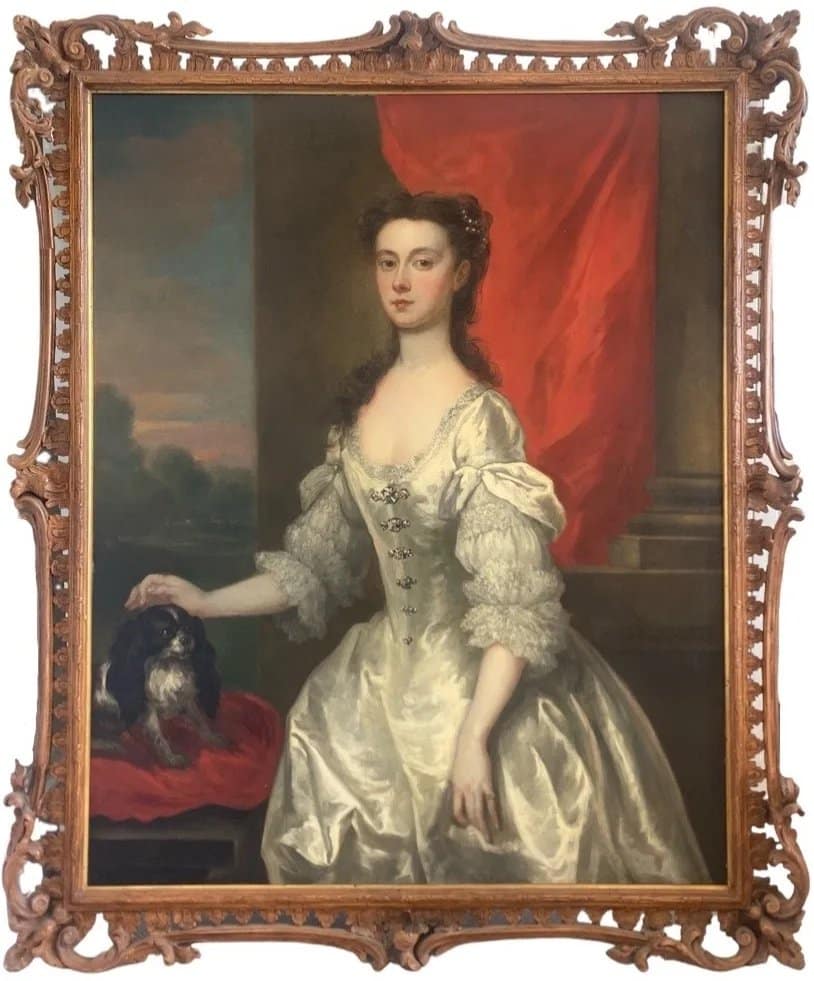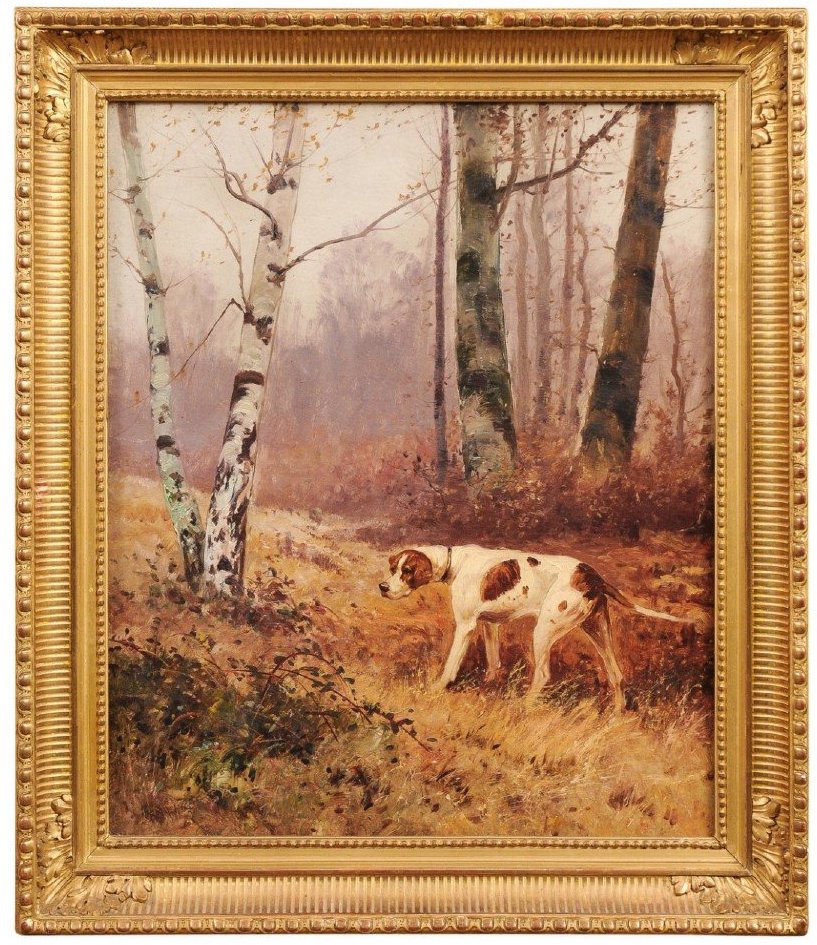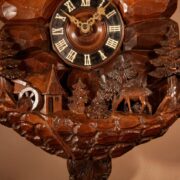Dogs have long held a special place in our hearts, becoming beloved aides, companions, and even family members. The important role they play in human life extends beyond their day to day presence in our homes, our love for them forever immortalized in the realm of art. Dogs have appeared in art since the earliest times, and their presence has only become more meaningful over the centuries as they became a constant companion in all walks of life. Their presence in art took on new symbolic meanings over time, holding a multifaceted symbolism that reflected the cultural, historical, and artistic contexts of the time. These furry companions played diverse roles, embodying various meanings and conveying messages that went beyond their individual presence.

Lord Methuen’s Spaniels by William Barraud. 19th century, oil on canvas. © Isherwood Fine Art
Status Symbols of the Elite
From the Middle Ages onwards, dogs in portraits often served as a symbol of wealth and social status. Owning a dog was a prerogative of the upper class, as dogs were costly to maintain and required considerable resources. In the competitive world of the aristocracy, owning a dog of a particular breed or with specific qualities became a way to showcase one’s high social standing. Dogs were carefully selected and bred for their physical attributes, temperament, and pedigree. Their presence in portraits served as a visual representation of the owner’s refined taste and elevated position within society. In many historical portraits, dogs are depicted in large-scale, often taking up a significant portion of the frame. This intentional portrayal emphasized the importance of these animals in the lives of the upper class and their profound influence on their owners’ status.

Portrait of a Child and Pet Dog. Artist unknown. 1660, oil on canvas. © Period Portraits
In addition to their role as status symbols, dogs in historical portraits also represented power, authority, and control. They were often seen by the side of prominent figures, reinforcing their dominance and command over their domain. Hunting dogs were frequently included in portraits to showcase the subject’s prowess as a skilled hunter. These dogs symbolized a connection to the noble sport of hunting, reserved for the aristocracy. Furthermore, the depiction of hunting scenes with dogs highlighted the subject’s power and control over the natural world.
On the other end of the spectrum, smaller lapdogs were often featured in portraits of ladies and members of the court. Lapdogs were a symbol of luxury and leisure, as they were associated with the leisurely lifestyle led by the upper class. Their presence in portraits emphasized the status and elegance of the women they accompanied. These lapdogs, often portrayed in the arms of their mistresses, symbolized companionship, affection, and refinement. They highlighted the softer and more delicate aspects of the sitter’s personality and reflected the ideals of courtly love and decorum.

Portrait of a Lady with a Spaniel by John Vanderbank (1694-1739). 18th century, oil on canvas. © Isherwood Fine Art
In addition to representing wealth, dogs in historical portraits also symbolized royalty and power. Throughout history, rulers and monarchs often used dogs as a way to convey their authority and dominance. These regal portraits would feature dogs at the side of rulers, signifying their ability to command not only humans but also the animal kingdom. The presence of dogs in these portrayals showcased the ruler’s strength and control, adding a layer of symbolism to the artwork. The presence of a faithful and fierce-looking dog emphasized the ruler’s ability to safeguard their kingdom and maintain order.

Portrait Of A Young Gentleman And His Greyhound by John Vanderbank. 18th century, oil on canvas. © Period Portraits
Symbolic Significance of Dogs
Dogs in portraiture often carried specific symbolic meanings, representing various qualities and characteristics. For example, a hunting dog might symbolize nobility, courage, and a connection to the natural world. Similarly, lapdogs or small breeds could be associated with luxury, refinement, and the upper class, signifying social status and wealth. Dogs were even incorporated into coats of arms, serving as symbols of power and lineage.

Portrait of Dogs and a Lamb, artist unknown. 19th century, oil on canvas. © Winckelmann Gallery
One of the most common characteristics that dogs were used to symbolize was loyalty and fidelity. Dogs have long been known for their unwavering loyalty and devotion to their human companions, one of the greatest reasons why they are so beloved. This quality was often celebrated in historical portraits, where dogs were depicted alongside their owners to highlight the bond between humans and animals. In many portraits, dogs were portrayed as beloved companions, emphasizing their role as loyal and trustworthy friends to their owners. They were portrayed nestled at the feet or by the side of their human counterparts, serving as a reminder of the deep bond between humans and animals. As a symbol of loyalty and devotion, dogs added emotional depth and warmth to the artworks.
The association between dogs and faithfulness in religious and mythological contexts added to their strong symbolic significance, their presence reinforcing the idea of loyalty as a virtue to be honored and emulated. By including dogs in the artwork, artists emphasized the value of loyalty and the trust and companionship shared between the subject and their furry friend. At the same time, the dog’s symbolic significance imprinted on the subject, highlighting faithfulness as a characteristic of the owner. These portrayals served as a reminder of the love and loyalty that dogs bring to our lives and bring out in us, transcending time and societal conventions.

A Pair Of Hounds Standing In A Landscape by Henry Frederick Lucas-lucas. 1889, oil on canvas. © Isherwood Fine Art
Roles and Functions in Society
Dogs played diverse roles in historical society, and these roles were often reflected in artistic representations. Hunting dogs, for instance, were frequently portrayed alongside hunters or aristocrats engaged in the sport. Their presence signaled not only the owner’s affinity for hunting but also the dog’s skill and prowess in assisting with the pursuit. Similarly, guard dogs were depicted in portraits to highlight the importance of protection and security. These portrayals not only showcased the practical value of dogs in different domains but also reinforced the societal roles and expectations associated with these animals.

Leashed Hounds Tied To A Tree, artist unknown. 18th century, oil on canvas. © Doyen Auction
However, depictions of dogs were not limited to their roles in the lives of the elite. Another way that dogs were incorporated into portraits was by portraying them alongside individuals engaged in labor or trade. These working dogs may have belonged to farmers, laborers, or merchants and were depicted as loyal companions, expressing the close bond between humans and their working animals. These paintings often romanticized the lives of the working class, highlighting the social bonds of working life. In aristocratic households, dogs were also often shown alongside servants, symbolizing their role as loyal attendants. These servant dogs were depicted as obedient and dutiful, just like the human servants they accompanied, traits that the wealthy patrons of the artist might have wished to encourage in their own staff.
As society progressed and evolved, dogs transitioned from being perceived purely as symbols of status and power to beloved family members and cherished companions. This shift in perspective is evident in the portraits of later centuries, where artists skillfully captured the emotional bond between humans and dogs. In these portraits, dogs are depicted as more than just accessories or status symbols. They are shown as loyal and loving beings, offering unconditional affection to their owners. The emotional connection between humans and dogs becomes a focal point, as the artist beautifully portrays the genuine affection and bond shared between them.

Portrait Of A Young Girl With Her Spaniel by Charles D’agar (1669 – 1723). Oil on canvas. © Period Portraits
The presence of dogs in these artworks symbolizes the warmth and companionship that they bring to people’s lives. Whether portrayed sitting at the feet of their owners or nestled in their laps, these dogs epitomize the loyalty and devotion that make them such beloved pets. The portrayal of dogs as cherished family members also reflects societal changes. As the importance of human emotions and connections grew, so did the recognition of dogs as beings capable of providing comfort, companionship, and unconditional love. The inclusion of dogs in portraits during this time was a testament to the value placed on the emotional aspects of human-dog relationships.

Spaniel Hunting Dog With Pheasant, artist unknown. 19th century, oil on canvas. © Monarts Gallery
Appreciation of Different Breeds
Dogs in historical portraits were not only symbols of power and status, but they also represented the desires and aspirations of their owners. Artists often depicted their patrons with specific dog breeds that were associated with certain characteristics or qualities. For example, a greyhound was commonly portrayed alongside aristocrats, symbolizing elegance and grace. On the other hand, a hunting dog might be included to showcase the owner’s love for outdoor activities and the pursuit of adventure. These deliberate choices of dog breeds in portraits helped to convey the personality and interests of the subject, showcasing their individuality and passions.

Portrait of Two Spaniels in an Interior by Sir Edwin Henry Landseer. 19th century, oil on canvas. © Isherwood Fine Art
Dog portraits also played a role in the wider recognition and establishment of specific breeds. Artists such as Sir Edwin Landseer in the United Kingdom or Rosa Bonheur in France created detailed and accurate depictions of various dog breeds. They started to pay closer attention to the anatomical details and distinctive features of specific dog breeds from the 19th century onwards, further highlighting the importance of dogs as subjects in art. These artworks not only celebrated the individual beauty and characteristics of each breed but also contributed to the formation of breed standards and the establishment of organizations like the Kennel Club and the American Kennel Club.

“His Master’s Voice” by Francis James Barraud (1856-1924). 19th century, oil on canvas. © Monarts Gallery
Man’s Best Friend
The presence of dogs in historical portraits goes far beyond their furry companionship. These loyal creatures were often used as symbols of power, loyalty, and family across the centuries. By delving into the cultural, historical, and artistic contexts of the time, we can gain a deeper understanding of the significance and meaning behind their inclusion. The portrayal of dogs in these portraits not only reflects the relationships between humans and animals, but also offers a glimpse into the social dynamics and values of the era. From regal hunting dogs to pampered lapdogs, each breed and depiction tells a story of its own. By exploring this fascinating subject, we not only appreciate the artistry behind these timeless portraits, but also gain a greater appreciation for the role and significance of dogs in art history.

Pointer Standing at the Edge of the Woods, artist unknown. French, 20th century. Oil on canvas. © Jacqueline Adams Antiques
You May Like
Portraits | Dogs in Art | Spaniels in Art | Greyhounds in Art | Animalier Bronze











